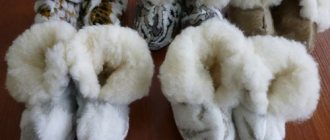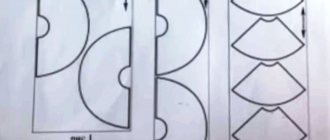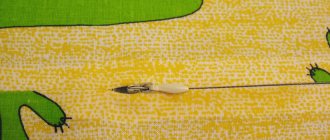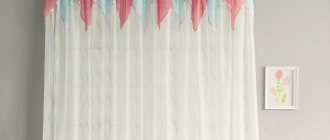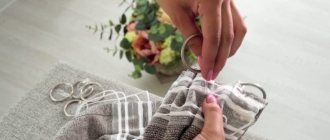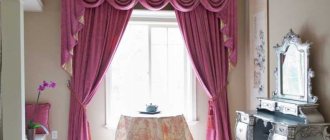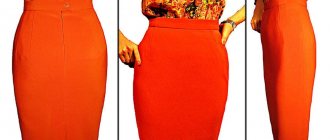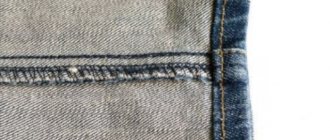A pillowcase is one of the elements of bed linen that protects the pillow from external influences, while maintaining its integrity and aesthetics. One pillowcase from another may differ in size, shape and sewing methods.
If you are wondering: “How to sew a pillowcase on a pillow quickly and easily?” and want to get an answer to it in an easily understandable and detailed form, then we will try to help you with this. Let's try it on our fingers, step by step, to explain to a schoolchild how to sew a pillowcase on a sewing machine, even without an overlocker.
Let us immediately note that we will sew a wrap pillowcase from a single piece of fabric.
From the means of labor we will need:
- tape measure
- scissors
- needles (pins)
- threaded sewing machine
Let's move on to the instructions.
We sew a decorative pillowcase “For your lazy self”
If you do not sew decorative pillows for sale, but want to refresh the interior of your room with new textiles, then this can be done by changing the cover on the decorative pillows of your sofa.
At the same time, I propose to minimize those necessary operations needed to sew a high-quality decorative pillow. We will sew from tapestry fabric and without sewing in a zipper.
So, to sew a pillowcase for one decorative pillow 40 x 40 cm we will need:
- finished pillow with filling measuring 38 x 38 cm;
- a piece of fabric approximately 50 x 110 cm;
- threads, pins, scissors;
- sewing machine.
In the future, I will call this product a pillowcase, a decorative pillowcase , so that there is no confusion.
I bought this piece of decorative fabric a long time ago - it’s a tapestry with geometric weaving.
There were ready-made pillows measuring 38 x 38 cm.
Of course, the size of the fabric texture squares did not match the size of the pillow. Therefore, it was necessary to cut out a pillowcase, placing the squares of the ornament from the center of symmetry of the pillow - in the horizontal and vertical directions.
And on the back side of the pillowcase there should be an overlap of fabric, which will replace the zipper.
First I found the axis of symmetry for the vertical direction of the fabric. Then for the horizontal one - to find out how much fabric I should cut taking into account the overlap.
Then I formed an overlap of the fabric and cut off the unnecessary piece.
One edge of the fabric was piping and did not require processing. And I folded the other edge, ironed it and processed it with a zigzag. Tapestry is a very dense and stubborn fabric; you shouldn’t bend it too much.
Now, on the wrong side of the fabric, you need to clearly mark the axis of symmetry of the pillowcase, its size is 20 cm on each side of the axis, and correctly position the overlap of the fabric.
We bend the fabric along the borders of the pillowcase (it is better to fix it with pins), turn it over to the back side and make an overlap.
All this is from the wrong side of the fabric.
First we place the edge processed with a zigzag.
And then we put the raw edge (or rather, processed at the factory) on top of it.
We chop off the overlap along the entire length with pins.
The result is a “pipe”. We turn it right side out and turn the overlap to face us.
Again we determine the center of symmetry and mark it equally on each side - to what square we will sew this overlap from the front part.
Since neither the pins nor the chalk line are visible on such a motley texture, I show these places with a pencil.
On the front side from above we sew a simple seam along the very edge to the place where the pencil lies. Then we set the “reverse” and return to the edge.
We do the same thing, symmetrically, on the opposite side of the fabric overlap.
Steam, iron. There is a hole left for the pillow.
Now we turn our pipe inside out again.
Here is the seam I sewed from the front part.
Steam and iron.
Now we need to make two seams on the pillowcase. After all, we no longer have seams, but two folds when the fabric is folded horizontally.
And there are only two more seams left to make in the vertical direction.
Everything is the same: the axis of symmetry is in the middle of the square, 20 cm from left to right. We sew.
Process with a zigzag. Let's imagine the excess.
And now the finale.
We begin to turn the pillowcase inside out through the hole from the overlap of the fabric!
Now we thoroughly steam and smooth the face.
Now we take the pillow, squeeze it and gradually push it into this hole.
It's like a boa constrictor swallowing a rabbit.
And voila!
Nothing will fall out or turn out! I have tested this method more than once. And the fixing seams that I sewed overlapping - they prevent the fabric from completely turning out. The hole size is approximately half the width of the pillow.
I did without a zipper, since sewing a zipper into a very thick and stubborn tapestry is a very labor-intensive task.
Materials
To sew a pillowcase you will need:
- thick linen fabric - calico or satin is best;
- threads;
- needles;
- sewing machine;
- scissors;
- material for decoration, if any (buttons, tulle);
- centimeter;
- ruler and pencil for drawing cutting lines.
There is no need to make a special drawing on paper, so there is no need for paper or cardboard. The only thing is that pins may be required to connect the tissue along the temporary scar.
Important! When calculating the required amount of material, the required centimeters are taken into account and another 5% is added to them. So, if you plan to tailor a product measuring 50 by 50 cm, then you will need two pieces of fabric, each at least 100 cm wide and high, plus 5-10 cm. Indentations are needed not only for scars, but also for smell, if we are talking about cutting a wrap pillowcase.
DIY pillows: how and what to decorate with?
In addition to beauty, practicality and durability, pillows should be easy to clean. This must be taken into account when decorating a pillow. You should not choose elements for decoration that are too small and fragile. For example, beads.
Important: The pillow cover must be removable so that it can be washed at any time. And if there is a lot of fragile decor on the pillow, then such covers should be washed by hand, otherwise machine washing will ruin your beautiful cover.
You can decorate a pillow in different ways; below you will see this after seeing numerous photos and ideas. You can decorate a pillow in the following ways:
- Embroidery (ribbons, satin stitch, cross stitch). The best option would be cross stitch. This pillow will be easy to wash, and you won’t have to worry about damaging the pattern. With ribbon embroidery the situation becomes more complicated. You will have to use a vacuum cleaner and wash the covers by hand.
- Application . There are many simple, but at the same time stylish applique options. Using patchwork technique. This technique involves stitching multi-colored scraps into a single whole. Such a bright pillow will enliven the interior and add color to the boring monochromatic colors of the room.
- Knitted covers . If you know how to crochet or knit, you can easily decorate a pillow. Knitted pillows are a fashionable accent in the interior.
- Old things . It would seem that unnecessary things can only be thrown away. But in fact, there are many good uses for such things.
- Pillows of non-standard shape . These pillows do not require additional decor. They themselves are a beautiful decoration for the room.
- Relief decor . It provides fertile ground for imagination. These can be ruffles, puffs, frills, weaving, etc.
- Game of colors . Several pillows with different harmonious colors will look cool and fresh in the interior.
- Tassels . The edges of the pillows can be decorated with tassels.
- Lace . This decor will make the pillow romantic, delicate, and sophisticated. A pillow with lace is suitable for girls.
Important: When choosing decor, you should not follow the principle: more of everything. This approach can end up being tasteless. It's better to choose one key element that will be the highlight of your pillow.
For example, as in the photo below. A simple button in the center of the pillow, combined with black and white stripes directed in different directions, makes the pillow original, but at the same time it does not catch the eye.
DIY pillow decor
Types of pillows
Depending on the shape, the following types of pillows are distinguished:
- square;
- rectangular;
- in the form of a horseshoe;
- in the form of a roller.
Sewing bedding
It is most comfortable and safest to sleep on a rectangular pillow. Square products often have a decorative purpose. Orthopedic pillows take a rectangular shape, since it is this shape that is considered the most acceptable from the point of view of orthopedists, suitable for the body to completely relax and rest during sleep. Horseshoe pillows are used on the train and if a person is forced to sit for a long time, leaning against the back of a bed or chair.
Such pillows are also called anti-stress pillows. The shape of the cushion is suitable for any purpose; elongated pillows are used for sleeping together; in addition, they are popular among pregnant women because they reduce the load on the spine, which is present even in sleep, which makes the question of how to sew pillowcases for pillows very relevant.
The minimum size of a standard pillow is 40 by 40 cm, the maximum is 70 by 70 cm. But there are other sizes, for example:
- 50 to 50;
- 50 to 60;
- 50 to 70;
- 60 to 60.
The size depends on the person’s preferences; in principle, you can order a pillow of any size or shape, the only problem is finding a pillowcase for it.
Pillowcase 60 by 60
Pillowcases for round sofa cushions
In addition to pillows that are used for sleeping, there are often decorative sofas in the apartment. They come in a variety of shapes: round, square, flower-shaped, etc.
Cutting fabric for a round pillow
Sewing a cover for a round pillow is no more difficult than for a square one. It needs a pattern. To make such a pillowcase, measure the diameter of the pillow and add approximately 1.5 cm for seam allowance. The pattern is pinned to the canvas, and part of the front side of the cover is cut out.
Place the pieces right sides together and machine sew a seam along the basting line.
A line is drawn across the pattern for the zipper. Then, for the backing piece, the pattern is cut into two parts. A line is drawn for the zipper along the canvas. Parts of the pattern are moved apart, parts are cut out taking into account seam allowances, including on the straight edge.
We cut the seam allowances around the circumference, turn the cover inside out, insert the pillow through the unstitched area
The back seam is pinched and sewn, leaving a hole for the zipper. Next, the pillowcase is finished in the same way as in the case of a square pillow.
Sewing the open area of the pillow with hidden stitches
A ready-made round pillow will decorate your interior
Beautiful DIY pillows: ideas, photos
Decorative pillows attract the attention of needlewomen because they are easy to sew and look beautiful. If you trust your intuition and inspiration, everything will definitely work out. But even if you are not very happy with the result, you can always sew a new cover and send the previous one to another room.
The decor of pillows helps make them unique, unusual, so that it is impossible to take your eyes off. We have collected for you ideas of beautiful pillows that you can make with your own hands if you give free rein to your imagination.
Beautiful decor ideas
Beautiful DIY pillows
Beautiful pillow decor
Beautiful pillow decorated with burlap and a flower
If you cannot find a suitable pillow on sale, try sewing it yourself, because most models are very easy to sew. We invite you to watch a video on how to make a pillow using the patchwork technique.
What fabric to choose for a pillowcase. Fabric consumption
The modern standard for the width of calico and chintz is 220cm. It is the most profitable to sew bed linen from this width of fabric. When sewing a set with two pillowcases, there is practically no leftover calico left. The consumption of fabric, in monetary terms, is generally less than when sewing the same size of bed linen from fabric 150 cm wide. If you decide to buy fabric and sew bed linen with your own hands, we recommend buying fabric 220 cm wide. You can check and calculate it yourself, but Take my word for it, this has been tested by practice.
In order to sew 70X70 pillowcases from such fabric, you will need exactly 75cm per pillowcase, but there will be a remainder of approximately 40cm. But when cutting 3 pillowcases of this size at once, the fabric consumption for each will be on average 60 cm. The fabric consumption for a standard double set is approximately 7 meters, with a calico width of 220 cm.
Pillowcases can be cut in any direction, both along the grain and along the transverse thread. The main thing is that the pattern matches the rest of the bedding. This is why it is not always convenient to buy fabrics with large patterns. A large pattern will be difficult to fit into a pillowcase pattern. However, again, from our practice, we can advise not to “adjust” the pattern, but rather to use the fabric, as it is laid out. As a rule, very original sets are obtained. The only thing you should pay attention to is that a large pattern, especially animals, was still placed entirely on the pillowcase, at least on one side. And one more piece of advice, do not buy inexpensive “cheap” fabrics in the literal and figurative sense of the word. Believe me, you will not save anything, since the durability of such bed linen is 5-10 times less than, for example, from Shuya calico.
